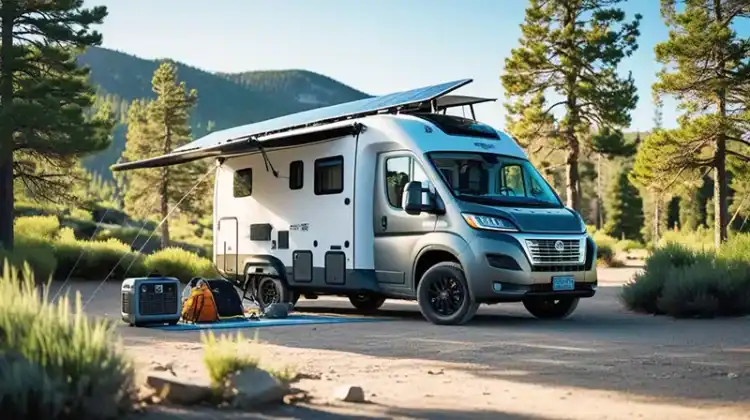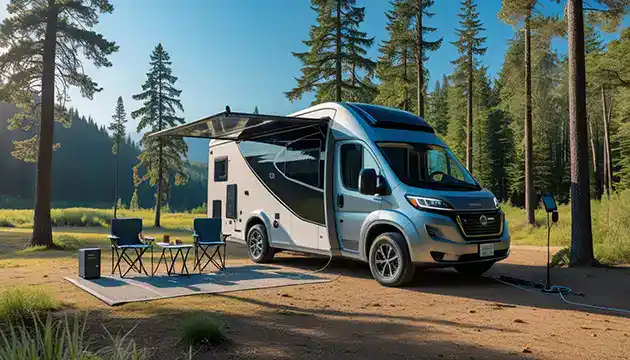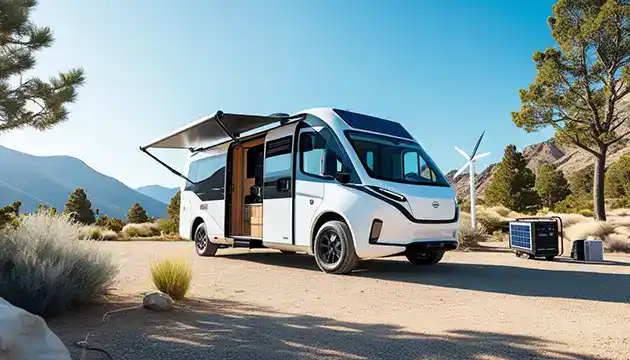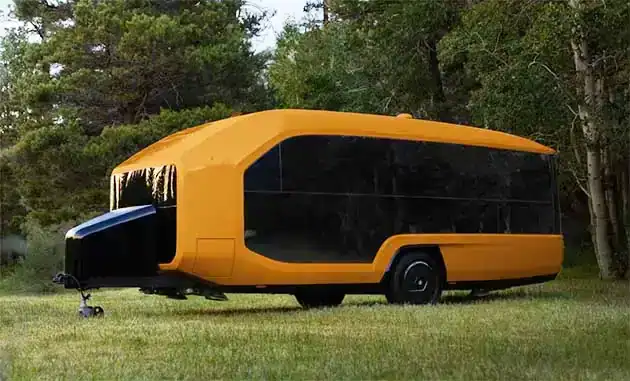
Thank you for reading our post, please rate this article at the end.
Reading Time: 10 minutesLast Updated on September 23, 2025 by Paul Clayton
Table of Contents
Electric RVs Are Here: Off-Grid Capabilities
Key Takeaways
-
- Electric RVs are Here: Electric RVs have transitioned from concepts to deliverable products from companies like Winnebago, Pebble, and Grounded, offering zero-emission travel and significant off-grid capabilities.
- Key Differentiators: Unlike traditional RVs, electric models use a single electric system for both driving and living functions, provide quiet operation, instant torque, and lower maintenance needs, often incorporating regenerative braking.
- Core Off-Grid Features: These RVs excel off-grid through integrated solar panel systems (e.g., 400W to 1000W+ arrays), high-capacity lithium-ion battery banks (100kWh to 200kWh+), and smart energy management systems. Some even feature advanced water generation (e.g., atmospheric water generators).
- Battery Technology Advances: Modern electric RVs primarily use Lithium Iron Phosphate (LiFePO4) batteries for faster charging, longer lifespan (3,000+ cycles), and higher usable capacity. They also feature thermal management for extreme weather and offer modular designs for expandable capacity.
- Top Models & Options: Standout models include the luxurious Living Vehicle HD Pro, Winnebago’s eRV2, and Pebble Flow travel trailer. Budget-friendly options like Keystone Coleman 13B and Forest River Wolf Pup 16EV are also available.
- Real-World Success & Innovation: Campers are successfully using electric RVs for extended off-grid trips, appreciating the quiet operation. Innovations include retractable solar roofs, high-voltage battery packs, and expandable living areas.
- Considerations & Challenges: Electric RV ownership requires careful range planning (100-400 miles per charge) and understanding charging infrastructure limitations in rural areas. Higher upfront costs and battery weight are current challenges, though cost reduction and EV towing capabilities are improving.
- Future Outlook: The market is rapidly expanding with new models, continued battery tech advancements, and anticipated features like autonomous driving and advanced sustainable systems (e.g., hydrogen extended-range, water extraction from air).
Electric RVs have evolved from concept vehicles to real products you can buy today. Companies like Winnebago, Pebble, and Grounded are now delivering fully electric motorhomes and trailers that can power your adventures without relying on campground hookups. These new electric RVs combine zero-emission travel with advanced battery systems and solar panels that let you camp off-grid for days or even weeks.
The latest models showcase impressive capabilities that solve traditional RV problems. Pebble’s Flow travel trailer offers 45,000-watt-hours of lithium battery storage with up to 1,100 watts of solar panels. Grounded’s G3 motorhome provides up to 286 miles of driving range and can operate in temperatures as low as zero degrees Fahrenheit.
We’re seeing a shift in how people think about RV travel. These electric models don’t just replace gas engines with batteries. They redesign the entire camping experience with smart technology, app-controlled features, and energy systems that work together to extend your time in remote locations.
Electric RVs With Off-Grid Capabilities

Electric RVs now combine zero-emission travel with extended off-grid living through solar integration, high-capacity batteries, and advanced power management systems. These vehicles can operate independently for days without external power sources while providing full comfort amenities.
What Sets Electric RVs Apart
Electric RVs differ from traditional models through their integration of renewable energy systems and electric powertrains. Many models feature solar panels to generate additional power and extend the vehicle’s off-grid capabilities, allowing travelers to camp in remote locations without external power sources.
The Winnebago e-RV offers 125 miles of range and powers all camper features, including a marine-grade fridge, water heater, and roof-mounted air conditioning from its main battery. This eliminates the need for separate generators or propane systems.
Key Differentiators:
- Single electric system powers both driving and living functions
- Quiet operation without engine noise or emissions
- Instant torque delivery for better hill climbing
- Lower maintenance requirements than gas engines
Modern electric RVs also feature regenerative braking systems. These capture energy during deceleration and downhill driving to extend range and reduce brake wear.
Core Off-Grid Features
Solar panel systems form the backbone of electric RV off-grid capabilities. The eTH electric RV features a retractable solar panel roof that generates over 25kWh of daily power for extended wilderness stays.
Advanced water generation systems eliminate the need for frequent refills. The eTH includes an Atmospheric Water Generator that converts air moisture into 50 liters of clean drinking water daily.
Essential Off-Grid Systems:
- Solar Arrays: 400W to 1000W+ roof-mounted panels
- Battery Banks: 100kWh to 200kWh+ lithium-ion systems
- Inverters: Pure sine wave units for sensitive electronics
- Water Systems: Atmospheric generators and large freshwater tanks
- Waste Management: Composting toilets and greywater recycling
Smart energy management systems automatically balance power consumption between driving, cooking, climate control, and device charging. These systems prioritize essential functions when battery levels drop.
New vs. Used RV: Navigating the Price Trend
Can You Rent an RV for a Year?
Advances in Battery Technology
Modern electric RVs use lithium iron phosphate (LiFePO4) batteries that offer superior performance over traditional lead-acid systems. These batteries charge faster, last longer, and provide consistent power output throughout their discharge cycle.
High-capacity batteries now offer ranges up to 300 miles on a single charge, with fast-charging capability that recharges 80% in under an hour. This makes long-distance travel more practical for electric RV owners.
Battery Technology Improvements:
| Feature | Traditional Lead-Acid | Modern LiFePO4 |
|---|---|---|
| Cycle Life | 500-800 cycles | 3,000+ cycles |
| Depth of Discharge | 50% recommended | 95% usable |
| Charge Time | 8-12 hours | 2-4 hours |
| Weight | Heavy | 50% lighter |
Battery thermal management systems maintain optimal operating temperatures in extreme weather. These systems use liquid cooling or heating elements to protect battery cells and maintain performance in hot summers or cold winters.
We’re seeing modular battery designs that allow owners to add capacity based on their specific off-grid needs. The Pebble Flow features swappable battery packs that can be charged separately or expanded for longer wilderness stays.
Top All-Electric RVs and Trailers for Off-Grid Travel

Electric RVs now offer impressive battery capacity and solar integration for extended off-grid stays. Leading manufacturers are releasing models with advanced lithium battery systems and high-wattage solar arrays that can power appliances for days without hookups.
Standout Electric RV Models
The Living Vehicle HD Pro leads the premium market with 72 kilowatt-hours of energy storage and 18 kilowatts of power generation. This solar-powered luxury travel trailer can run all systems, including air conditioning, for extended periods.
Winnebago’s eRV2 represents the next generation of electric motorhomes. It features integrated solar panels and lithium battery banks designed for week-long boondocking trips.
The Pebble Flow offers automated setup systems powered entirely by electric motors. It’s a smart battery management system that optimizes power usage across all onboard systems.
These models eliminate the need for propane or gas generators. They provide quiet operation and reduced maintenance compared to traditional RVs.
Noteworthy Electric Trailers
Aero Build has established itself as a major player in all-electric trailer manufacturing. Their trailers feature all-season construction and remarkable off-grid capabilities for indefinite stays.
Budget-friendly options include the Keystone Coleman 13B and Forest River Wolf Pup 16EV and 17EV. These affordable all-electric travel trailers eliminate propane dependence while maintaining essential amenities.
The Cherokee Grey Wolf 26EV offers more space for families wanting electric camping. It includes LED lighting, electric heating, and battery-powered ventilation systems.
All these trailers use lithium battery technology for longer power retention and faster charging times.
Solar-Equipped RV Options
Modern travel trailers with solar combine off-grid freedom with home-like comfort. Solar arrays range from 400 watts on smaller units to over 1,000 watts on larger models.
Integrated solar systems include charge controllers, inverters, and battery monitors. These components work together to maximize energy collection and storage efficiency.
Portable solar options allow owners to position panels for optimal sun exposure. This flexibility increases charging capacity when parked in shaded areas.
Battery capacities typically range from 200 to 800 amp-hours in lithium configurations. This storage powers lights, fans, water pumps, and small appliances for multiple days without sunlight.
Real-World Experiences and Innovations

Electric RVs have moved from concept to reality with manufacturers delivering functional models and campers sharing their experiences. Two electric RV manufacturers have new models available this month, while emerging technologies continue to enhance off-grid capabilities.
Off-Grid Camping Success Stories
Real campers are now using electric RVs for extended off-grid adventures. Grounded’s updated G3 motorhome delivers reliable performance for Type B camping experiences.
Pebble began full production and is delivering its first electric travel trailers to customers this week. Both companies report successful off-grid capabilities that meet real-world camping needs.
The eTH electric RV boasts a luxurious interior and smart tech, powered by clean energy, allowing for a full week of off-grid use. Its retractable solar panel roof generates over 25kWh of power daily.
Campers report quiet operation as a major benefit. Electric motors eliminate generator noise that traditionally disrupts the outdoor experience.
Emerging Innovations for Electric RVs
Winnebago’s e-RV Series offers a 125-mile range on a full charge with solar panel integration as standard equipment. The near-silent operation transforms the camping experience completely.
Key innovations include:
- Solar panel integration for continuous charging
- Battery systems lasting multiple days without hookups
- Smart home technology for remote monitoring
- Lightweight construction reduces power consumption
THOR Industries introduced its Electric Vision Vehicle with high-voltage battery packs designed specifically for off-grid camping. The system enhances power storage capacity significantly.
Companies like AC Future unveiled electric motorhomes that transform into spacious living areas. These expandable designs maximize interior space while maintaining aerodynamic efficiency during travel.
Key Considerations for Electric RV Owners
Range planning becomes critical for electric RV trips. Most current models offer 100-400 mile ranges depending on terrain and usage patterns.
Essential factors to consider:
| Factor | Impact | Solution |
|---|---|---|
| Charging infrastructure | Limited rural availability | Plan routes around charging stations |
| Battery degradation | Reduced capacity over time | Regular maintenance and proper storage |
| Weight considerations | Batteries add significant weight | Check towing and payload limits |
Solar panel systems require proper positioning for maximum efficiency. We recommend understanding your power consumption patterns before extended off-grid trips.
Weather conditions significantly affect battery performance. Cold temperatures can reduce range by 20-30% compared to optimal conditions.
Purchase timing matters as new RV brands are pushing boundaries with improved solar power and smart home integration features.
The Future of Electric RVs and Off-Grid Adventures
The electric RV market is rapidly expanding with major manufacturers launching new models and advancing battery technology. We’re seeing significant growth predictions alongside practical challenges that the industry must address.
Market Trends and Predictions
Major RV manufacturers are investing heavily in electric technology. Winnebago has developed electric concepts with plans to create various-sized electric vehicles with OEM partners.
The Pebble Flow Electric RV represents sustainable off-grid adventure capabilities. It combines nostalgia with modern technology for eco-conscious travelers.
Key market developments include:
- All-electric propane-free systems
- Advanced lithium battery banks
- Solar integration capabilities
- Lightweight designs for EV towing
Airstream’s Basecamp 20Xe leads with a 10.3 kWh lithium battery pack and 600W solar panels. These systems enable extended off-grid camping without fossil fuels.
The industry expects autonomous features and smart control systems accessible through mobile apps. These advances will make RVing more user-friendly.
Challenges and Opportunities Ahead
Electric RVs face infrastructure limitations. Charging networks need expansion to support long-distance travel with heavy trailers.
Primary challenges include:
- Limited charging stations in remote areas
- Higher upfront costs compared to gas models
- Battery weight affects towing capacity
- Range anxiety for extended trips
However, opportunities are growing rapidly. We see seven manufacturers bringing electric trailers to market in 2024 alone.
Cost reduction will come through mass production and improved battery technology. Solar panel efficiency continues improving, making off-grid power more reliable.
EV towing capabilities are expanding as automakers release more powerful electric trucks and SUVs. This creates a larger market for electric travel trailers.
Advanced technologies include hydrogen extended-range systems and solar-powered trailers that extract water from air. These innovations will solve current limitations.
Frequently Asked Questions
Electric RV buyers typically face questions about pricing, charging infrastructure, range capabilities, and manufacturer options. Current models range from $200,000 to over $500,000, with charging times varying from 30 minutes to several hours depending on the system used.
What is the average price range for an all-electric RV currently on the market?
Electric RVs currently cost between $200,000 and $500,000 for most models. The Winnebago eRV2 starts around $300,000, while luxury options can exceed $450,000.
Pebble Flow travel trailers offer a more affordable entry point at approximately $109,500. These prices reflect the advanced battery technology and electric drivetrain systems required for off-grid capabilities.
The higher upfront costs compared to traditional RVs stem from expensive lithium battery packs and electric motor systems. However, lower fuel and maintenance costs can offset some of this premium over time.
How long does it take to charge an electric RV, and what types of charging options are available?
Electric RV charging times depend on the power source and battery capacity. DC fast charging can restore 80% battery capacity in 30 to 60 minutes at high-speed stations.
Level 2 charging at campgrounds takes 4 to 8 hours for a full charge. Standard 110-volt outlets require 12 to 24 hours, making them impractical for regular use.
We can also use solar panels and battery storage systems to maintain power while camping off-grid. This setup provides energy independence but requires adequate sun exposure.
What are the typical range and battery life for electric RVs with off-grid capabilities?
Current electric RVs achieve 200 to 300 miles per charge under normal driving conditions. The Lightship L1 targets a best-in-class range of 300 miles with its advanced power system.
Grounded’s G3 models offer up to 286 miles on a single charge using the GM BrightDrop platform. Range decreases with heavy loads, steep terrain, or extreme weather conditions.
Battery life typically lasts 8 to 15 years with proper maintenance. Off-grid capabilities allow 2 to 5 days of camping without external power sources, depending on usage patterns and solar charging capacity.
Which manufacturers are leading the way in electric RV production, and what models do they offer?
Winnebago leads with the eRV2, built on the Ford E-Transit chassis with comprehensive off-grid systems. Thor Industries produces several electric models focused on off-grid camping capabilities.
Lightship develops the L1 all-electric travel trailer with an innovative aerodynamic design. Pebble Flow creates smart travel trailers with app-controlled features and electric assistance.
Grounded offers the G3 series on GM’s BrightDrop platform in 20-foot and 24-foot configurations. These manufacturers focus on combining electric propulsion with robust off-grid power systems.
Can electric RVs with off-grid capabilities truly provide a reliable and sustainable travel experience?
Electric RVs with solar power and battery systems can sustain off-grid camping for multiple days. The combination of electric propulsion and renewable energy creates a genuinely sustainable travel option.
Reliability depends on proper planning and understanding system limitations. We need to consider charging infrastructure availability and weather conditions that affect solar generation.
Battery technology continues improving, making electric RVs more dependable for extended off-grid adventures. The integration of smart energy management systems helps optimize power usage automatically.
What are the interior space and amenity differences compared to traditional, fuel-based RVs?
Electric RVs often feature more interior space due to compact electric drivetrains. The absence of large diesel engines and fuel tanks allows for creative floor plan designs.
Battery placement under the floor maintains interior room while lowering the center of gravity. Many electric models include digital control systems for monitoring power usage and system status.
We typically find similar amenities to traditional RVs, including kitchens, bathrooms, and sleeping areas. However, some models prioritize energy-efficient appliances and LED lighting to maximize battery life during off-grid stays.
Final Thoughts
Electric RVs represent a significant leap forward in recreational travel, offering a compelling blend of zero-emission mobility and robust off-grid living capabilities. By leveraging advanced battery technology, integrated solar solutions, and smart energy management systems, these vehicles are redefining the camping experience, providing unprecedented independence and quiet operation.
While challenges like charging infrastructure and initial cost exist, the rapid pace of innovation and increasing market offerings suggest a future where reliable, sustainable, and truly off-grid RV adventures are widely accessible.
Home page
Back to the top of the page





